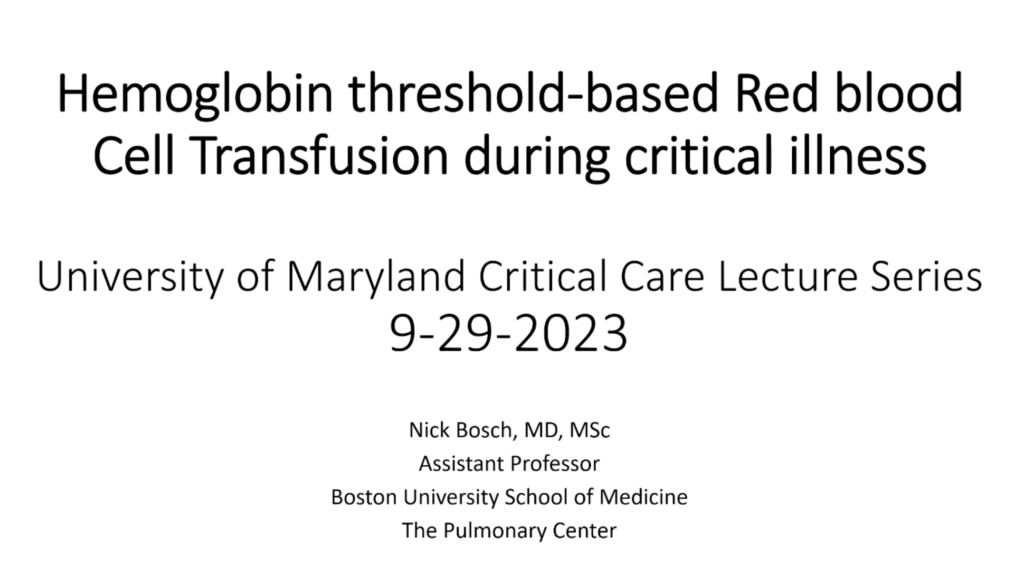Dr. Hong Kim is back – this time to discuss two classic hemoglobinopathies. Do you you know the common iatragenic causes of methemoglobinemia? How about when to send a patient for hyperbaric oxygen for carbon monoxide exposure? If not, this is a can’t miss lecture.
Podcast: Play in new window | Download
Subscribe: Apple Podcasts | RSS
Written summary by Ahmad Aswad
Carbon Monoxide Toxicity
- In the U.S. common sources of exposure include residential fire (with cyanide as a potential co-exposure), engine exhaust, natural gas appliances, propane-powered engines, & paint stripper ingestion.
- Normal: Physiologic carboxyhemoglobin (COHb) levels: 1-2% in healthy individuals, up to 5-10% in smokers!
- Pathophysiology: Once inhaled/absorbed it binds to hemoglobin with 250 times higher affinity than oxygen causing “functional” anemia. Mitochondrial dysfunction also a major cause of clinical decompensation.
- Symptoms: At about 10%: Begins with headache, dizziness at level >10%, can progress to unconsciousness, death with levels above 50%
- Diagnosis
- Lab: CO-oximetry
- Radiology: CT head shows basal ganglia lesions
- Treatment
- Primary treatment: Removal from exposure, 100% FiO2 by non-rebreather mask
- t1/2: CO half-life is 5 hours
- Hyperbaric Oxygen (HBO) Therapy: causes dissociation of CO from Hb, myoglobin, and cytochrome oxidase in the mitochondria
- Decreases half-life to 23 minutes
- HBO may also antagonize lipid peroxidation and decrease leukocyte adhesion, minimizing the inflammatory response.
- Survivors may develop delayed neuropsychiatric sequelae and cognitive impairment weeks after exposure.
- Risk factors of delayed reactions include LOC, age> 30 & duration of CO exposure.
- Case reports suggest that HBO initiated within 6 hours from exposure may prevent delayed neurologic sequelae
- Indications for HBO
- Levels of CO Hb >25 %, ( >15 % in pregnant and pediatric population, expert opinion)
- Clinical symptoms: Chest pain, dizziness, syncope, seizures, coma, focal neurological findings, pregnancy
- Cochrane review: insufficient evidence to support HBO use
- American college of emergency physicians (ACEP): HBO a therapeutic option, cannot be mandated
Methemoglobin (MetHb)
- Both hereditary & toxic forms of methemoglobinemia exist
- Normal levels are 1-3%
- Pathophysiology: Oxidizes iron moiety to Fe3+ in hemoglobin leading to inability to carry oxygen.
- Clinical findings
- May not be symptomatic up until levels above 20%, with death occurring at levels above 70%
- Pulse oximetry shows hypoxemia with saturation levels <90%
- SpO2 usually stays around 85% as levels of MetHb increase
- Precipitants
- Common drugs: Dapsone, benzocaine, phenazopyridine, amyl nitrites and anti-malarials.
- Chemicals such as aniline dye, organic nitrites, and nitrates food preservatives.
- Treatment: Methylene blue
- Indication: Symptomatic patients and MetHb >25%. Response is seen within minutes and dose may be repeated once.
- Mechanism: Fe3+ oxidized to Fe2+ via NADPH dependent pathway
- Can cause hemolysis, decreased pulse-oximetry, and can potentially cause serotonin syndrome.
- Can be considered in patients with G6PD deficiency only in very life threatening cases, as hemolysis will often be seen 24 hours later.
- Alternative treatment options: Exchange transfusion, HBO, and ascorbic acid (slow response)
Suggested Reading
- Scheinkestel CD, Bailey M, Myles PS, et al. Hyperbaric or normobaric oxygen for acute carbon monoxide poisoning: a randomised controlled clinical trial. Med J Aust. 1999;170(5):203-10. [PubMed Link]
- Pallais JC, Mackool BT, Pitman MB. Case records of the Massachusetts General Hospital: Case 7-2011: a 52-year-old man with upper respiratory symptoms and low oxygen saturation levels. N Engl J Med. 2011;364(10):957-66. [PubMed Link]
- Weaver LK, Hopkins RO, Chan KJ, et al. Hyperbaric oxygen for acute carbon monoxide poisoning. N Engl J Med. 2002;347(14):1057-67. [PubMed Link]



